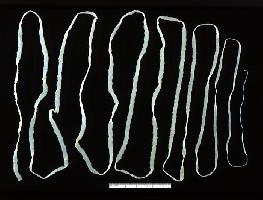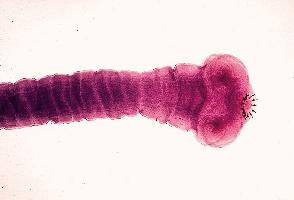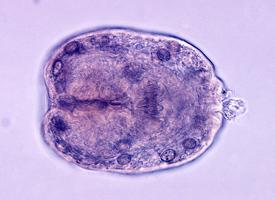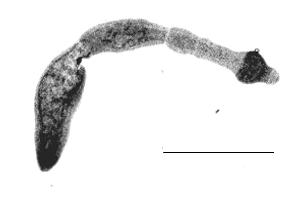
Váhy a míry
| Délka | od 3 do 5 m |
|---|
Popis zvířete
The Beef tapeworm, scientifically known as Taenia saginata, is a parasitic flatworm belonging to the class Cestoda. It is one of the most common tapeworms infecting humans, primarily transmitted through the consumption of undercooked or raw beef contaminated with the larval stage of the parasite, known as cysticerci. The adult tapeworm resides in the human intestine, where it can live for many years, reaching lengths of up to 10 meters or more, making it one of the longest parasites that can infect the human body.The life cycle of Taenia saginata is complex, involving two hosts: humans and cattle. The cycle begins when cattle ingest vegetation contaminated with tapeworm eggs, which are passed into the environment through the feces of an infected human host. Once inside the cattle, the eggs hatch into larvae, which then penetrate the intestinal wall and migrate through the bloodstream to muscle tissues. There, they form cysts, completing the larval stage. When humans consume raw or undercooked beef containing these cysts, the cycle continues. Inside the human intestine, the cysts develop into adult tapeworms, which attach themselves to the intestinal walls using a series of hook-like structures on their head, known as a scolex.
The adult tapeworm does not possess a digestive system; instead, it absorbs nutrients directly through its skin from the host's digested food. This parasitic adaptation allows it to thrive in the nutrient-rich environment of the human intestine. As it grows, segments known as proglottids are produced, each containing both male and female reproductive organs, allowing the tapeworm to self-fertilize. Mature proglottids, filled with eggs, are eventually released from the end of the tapeworm and pass out of the host's body in the feces, ready to contaminate grazing areas and restart the cycle if ingested by cattle.
Infection with Taenia saginata, known as taeniasis, often goes unnoticed as it can be asymptomatic or present with mild symptoms such as abdominal discomfort, nausea, diarrhea, or weight loss. However, the presence of proglottids in the feces is a telltale sign of infection. Diagnosis is typically confirmed through microscopic examination of stool samples to identify eggs or segments of the tapeworm. Treatment involves administration of anthelmintic drugs, which are effective at expelling the parasite from the body.
Prevention of Taenia saginata infection is primarily focused on proper meat inspection and cooking. Meat should be cooked thoroughly to temperatures that kill the cysticerci, and meat inspection programs help identify and remove infected beef from the food supply. Public health education on the importance of cooking beef to safe temperatures also plays a critical role in preventing the spread of this parasite.
Overall, the beef tapeworm represents a fascinating example of a complex life cycle evolved to exploit both human and cattle hosts. Despite its potential to cause health issues, it is a parasite that can be controlled and prevented through relatively simple measures, highlighting the importance of food safety and public health practices in breaking the cycle of infection.
Podobná zvířata
Nové fotografie zvířat
Top 10 zvířat
- Chinese water dragon (Physignathus cocincinus)
- Galápagos tortoise (Geochelone nigra complex)
- Dolphin gull (Leucophaeus scoresbii)
- Japanese macaque (Macaca fuscata)
- Colombian red howler (Alouatta seniculus)
- Sea urchins (Echinoidea)
- Diana monkey (Cercopithecus diana)
- Moustached guenon (Cercopithecus cephus)
- Colossal squid (Mesonychoteuthis hamiltoni)
- Common reed warbler (Acrocephalus scirpaceus)


